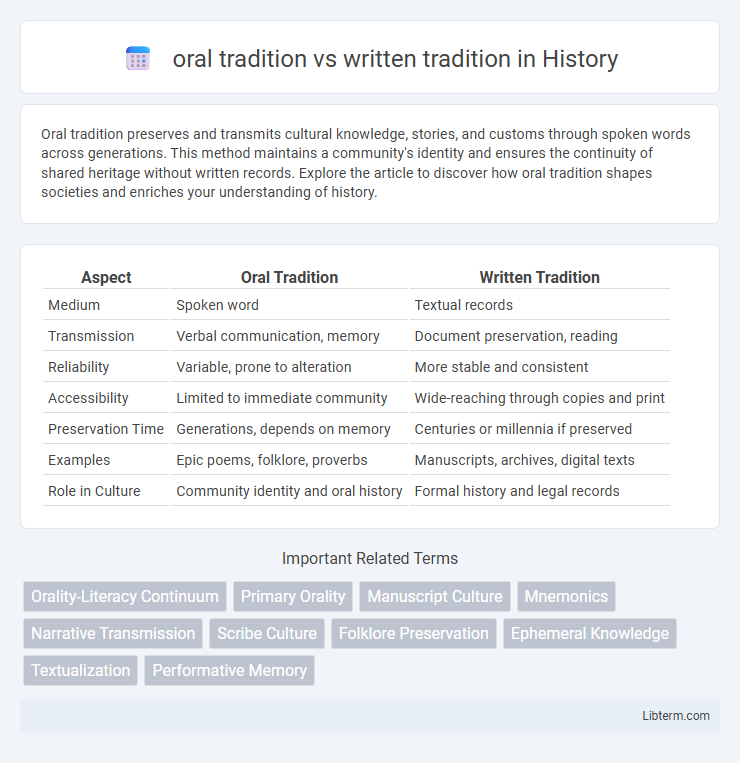Oral tradition preserves and transmits cultural knowledge, stories, and customs through spoken words across generations. This method maintains a community's identity and ensures the continuity of shared heritage without written records. Explore the article to discover how oral tradition shapes societies and enriches your understanding of history.
Table of Comparison
| Aspect | Oral Tradition | Written Tradition |
|---|---|---|
| Medium | Spoken word | Textual records |
| Transmission | Verbal communication, memory | Document preservation, reading |
| Reliability | Variable, prone to alteration | More stable and consistent |
| Accessibility | Limited to immediate community | Wide-reaching through copies and print |
| Preservation Time | Generations, depends on memory | Centuries or millennia if preserved |
| Examples | Epic poems, folklore, proverbs | Manuscripts, archives, digital texts |
| Role in Culture | Community identity and oral history | Formal history and legal records |
Defining Oral and Written Traditions
Oral traditions consist of knowledge, stories, and cultural values transmitted verbally across generations, relying on memory and performance to preserve community identity. Written traditions involve recording information in texts or documents, enabling precise preservation and dissemination of ideas beyond immediate social groups. Both forms play crucial roles in safeguarding history, but oral traditions emphasize fluidity and adaptation, while written traditions prioritize durability and accuracy.
Historical Origins and Development
Oral tradition, dating back to prehistoric times, served as the primary method for transmitting culture, history, and knowledge through storytelling, songs, and rituals before the widespread use of writing systems around 3400 BCE in Mesopotamia. Written tradition emerged with early cuneiform and hieroglyphic scripts, enabling the preservation of complex information, laws, and literature across generations with greater accuracy and permanence. The evolution from oral to written traditions marked a pivotal development in human history, facilitating the expansion of civilizations, formal record-keeping, and the advancement of education and communication.
Modes of Transmission
Oral tradition relies primarily on memory and verbal communication, passing stories, customs, and knowledge through spoken word, songs, and rituals across generations. Written tradition utilizes texts, inscriptions, and manuscripts to preserve information in a fixed, durable form, allowing broader dissemination and long-term accessibility. The modes of transmission in oral tradition are inherently flexible and adaptive, while written tradition offers stability and consistency in preserving cultural heritage.
Preservation and Accuracy of Information
Oral tradition relies on memory and verbal transmission, which can lead to variations and loss of details over time, affecting the preservation and accuracy of information. In contrast, written tradition provides a stable and permanent record that enhances the fidelity and longevity of information across generations. Manuscripts, inscriptions, and digital archives serve as concrete evidence, enabling precise replication and reducing distortions caused by human error or selective recall.
Cultural Impact and Social Roles
Oral tradition fosters community cohesion and preserves cultural identity through storytelling, songs, and rituals, enabling generations to share collective knowledge and values in dynamic social settings. Written tradition formalizes cultural heritage, allowing precise documentation and widespread dissemination of laws, histories, and religious texts, which shapes societal structures and educational systems. Both forms serve distinct social roles: oral tradition emphasizes interpersonal communication and adaptability, while written tradition supports institutional authority and cultural continuity across time and geography.
Flexibility vs. Permanence
Oral tradition offers high flexibility, allowing stories and knowledge to adapt fluidly across generations, which supports cultural relevance and communal engagement. Written tradition, by contrast, provides permanence, preserving precise information and historical records in a stable form that resists alteration over time. This permanence ensures continuity and authoritative reference but limits the adaptive evolution inherent in oral transmission.
Influence on Language and Storytelling
Oral tradition shapes language through fluid, adaptive storytelling that relies on memory, repetition, and communal interaction, fostering linguistic creativity and variation. Written tradition preserves fixed narratives and standardized language forms, enabling complex plot structures and detailed descriptions that endure across generations. The interplay between oral dynamism and written permanence enriches cultural expression and language evolution.
Challenges and Limitations
Oral tradition faces challenges such as memory distortion, loss of information over generations, and lack of permanent records, which hinder accurate transmission of cultural knowledge. Written tradition, while preserving content more reliably, faces limitations including accessibility issues, literacy barriers, and the potential for misinterpretation due to lack of contextual oral cues. Both traditions must navigate these constraints to effectively maintain and convey historical and cultural heritage.
Modern Intersections and Adaptations
Modern intersections of oral and written traditions manifest in digital storytelling platforms that blend spoken narratives with textual content, enhancing accessibility and cultural preservation. Podcasts and social media amplify oral histories while written blogs and e-books document these narratives, creating a dynamic interplay between oral and written modalities. This fusion encourages interactive engagement, ensuring traditional knowledge evolves within contemporary communication landscapes.
Implications for Future Knowledge Sharing
Oral tradition ensures dynamic and context-rich knowledge transmission but risks loss or alteration over generations, emphasizing the need for methods that preserve authenticity. Written tradition provides permanence and accessibility, allowing information to be widely disseminated and referenced, supporting cumulative knowledge growth. Future knowledge sharing will likely integrate both mediums, leveraging digital technologies to enhance preservation, accuracy, and inclusivity.
oral tradition Infographic

 libterm.com
libterm.com